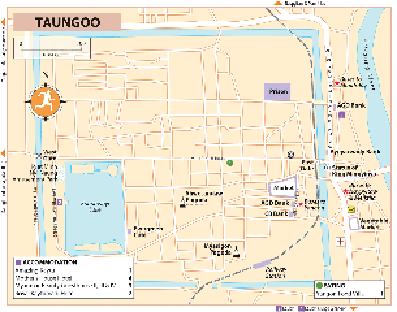Travel Reference
In-Depth Information
significance in the history of Myanmar as the centre of the
Taungoodynasty
, for a time one
of the largest empires in the history of Southeast Asia. Little remains of the city's glory days,
however,theroyalpalace havingbeenobliterated byJapanesebombersduringWorldWarII.
The heart of Taungoo is the original
moatedcity
- parts of the original moat survive, along
withafewfragmentsoftheoriginalcitywalls.Imposingneweasternandwestern
gates
were
built in 2010 to celebrate the city's five-hundredth birthday, with a large statue of Taungoo's
founder, King Mingyinyo, erected just outside the east gate for good measure. In the south-
western corner of the walled city, the fine
KandawgyiLake
is a pleasant spot for a bike ride
or stroll, with an attractive string of cafés along its eastern side and the fanciful temple-style
roofs of the
Royal Kaytumadi
hotel rising across the water.
Shwesandaw Pagoda
Daily 6am-9pm • Free
The most impressive of Taungoo's various temples, the
Shwesandaw Pagoda
sits more or
less in the centre of the old walled city, its large gilded stupa rising high above the surround-
ing streets. The stupa was built in 1597 on a sight of a much older structure which is said
to have contained hair relics of the Buddha (the temple's name means “Golden Sacred Hair
Relic”).
The most interesting approach is from the east, via a long covered walkway, initially lined
with shops selling assorted religious items before passing through a pretty jumble of stupas
and monastic quarters. From here, a short flight of steps leads up to a stupa, which is very
similar in outline to the Shwedagon in Yangon, with eighty-odd miniature stupas stacked
up around its lower two terraces. Various statues in glass cabinets stand around the terrace,
showing scenes from the life of the Buddha and processions of kings and monks, and murals
depict the gory punishments awaiting sinners in hell. A striking Mandalay-style Buddha sits

